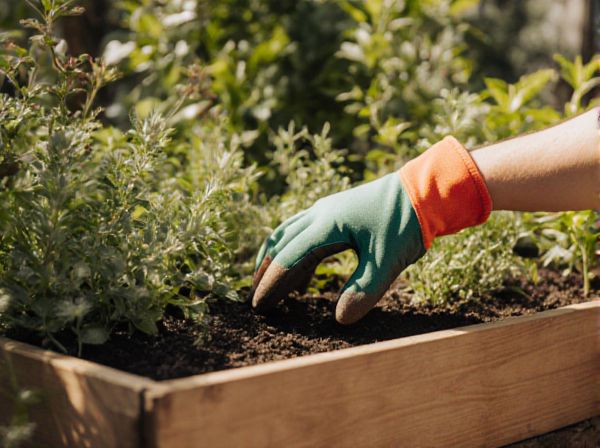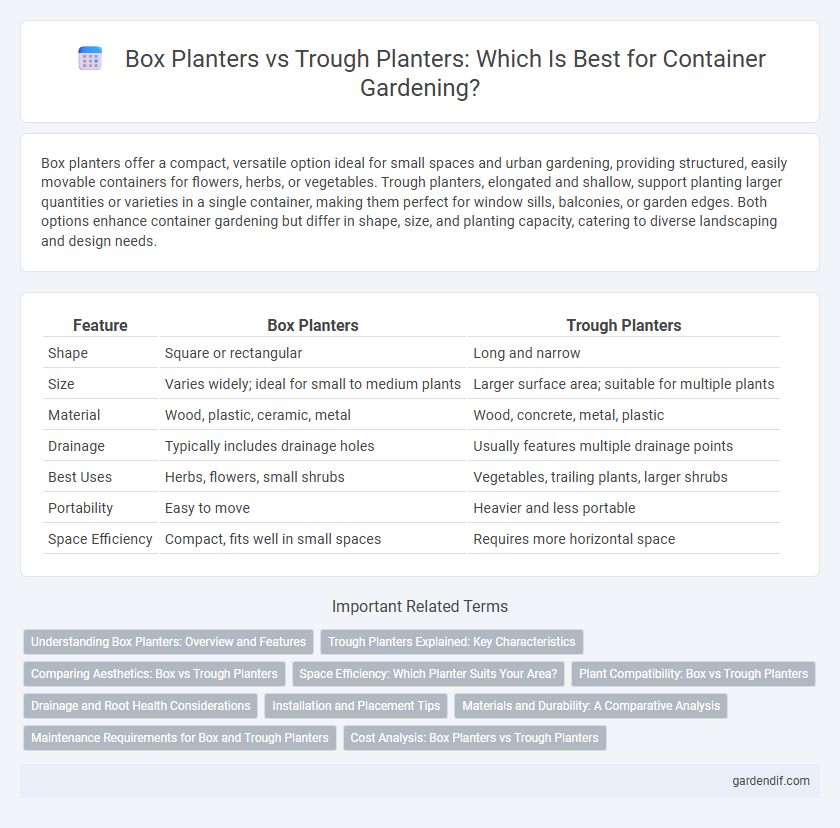
Box planters vs trough planters Illustration
Box planters offer a compact, versatile option ideal for small spaces and urban gardening, providing structured, easily movable containers for flowers, herbs, or vegetables. Trough planters, elongated and shallow, support planting larger quantities or varieties in a single container, making them perfect for window sills, balconies, or garden edges. Both options enhance container gardening but differ in shape, size, and planting capacity, catering to diverse landscaping and design needs.
Table of Comparison
| Feature | Box Planters | Trough Planters |
|---|---|---|
| Shape | Square or rectangular | Long and narrow |
| Size | Varies widely; ideal for small to medium plants | Larger surface area; suitable for multiple plants |
| Material | Wood, plastic, ceramic, metal | Wood, concrete, metal, plastic |
| Drainage | Typically includes drainage holes | Usually features multiple drainage points |
| Best Uses | Herbs, flowers, small shrubs | Vegetables, trailing plants, larger shrubs |
| Portability | Easy to move | Heavier and less portable |
| Space Efficiency | Compact, fits well in small spaces | Requires more horizontal space |
Understanding Box Planters: Overview and Features
Box planters are versatile gardening containers typically made from wood, metal, or plastic, known for their square or rectangular shape that maximizes planting space. These planters offer excellent drainage and root aeration, promoting healthy plant growth while their sturdy construction ensures durability for both indoor and outdoor use. Available in various sizes, box planters are ideal for growing herbs, flowers, or small vegetables, providing a structured and organized aesthetic to any garden or patio.
Trough Planters Explained: Key Characteristics
Trough planters are elongated containers designed to accommodate multiple plants or larger root systems, providing ample space for growth in narrow or confined locations. Typically made from durable materials like wood, metal, or high-quality resin, they offer excellent drainage and airflow essential for healthy plant development. Their versatile shape makes them ideal for creating linear garden beds, border plantings, or herb gardens on patios and balconies.
Comparing Aesthetics: Box vs Trough Planters
Box planters offer a structured, geometric appearance that complements formal garden designs, emphasizing clean lines and uniformity. Trough planters present a more elongated, rustic aesthetic that suits naturalistic or contemporary landscapes by providing a broader, flowing planting space. Choosing between box and trough planters depends on the desired visual impact and integration with surrounding garden styles.
Space Efficiency: Which Planter Suits Your Area?
Box planters maximize vertical space with their tall, narrow design, ideal for small balconies or patios where footprint is limited. Trough planters spread horizontally, offering more surface area for multiple plants, better suited for wider spaces like ledges or window sills. Selecting between box and trough planters depends on your available space and the types of plants you want to grow.
Plant Compatibility: Box vs Trough Planters
Box planters offer excellent compatibility for a wide range of plants, particularly for deep-rooted species and individual specimens due to their taller and more confined structure. Trough planters are ideal for low-growing, spreading plants, succulents, and small herb gardens, benefiting from their elongated shape that supports dense, horizontal planting arrangements. Both types provide versatile container gardening options, but plant choice should align with the planter's depth, width, and drainage characteristics to optimize growth.
Drainage and Root Health Considerations
Box planters typically offer superior drainage due to their deeper structure and often have multiple drainage holes, promoting healthy root aeration and preventing waterlogging. Trough planters, being wider and shallower, may require careful monitoring to avoid poor drainage, which can lead to root rot and restricted root growth. Ensuring adequate drainage systems in either planter is essential for maintaining optimal root health and preventing fungal diseases.
Installation and Placement Tips
Box planters require stable, level surfaces and benefit from placement in areas with adequate sunlight and drainage to prevent waterlogging. Trough planters, being long and narrow, are ideal for window sills or narrow balconies where space optimization is crucial. Position both types near water sources for easy irrigation and consider elevation on stands or risers to enhance airflow and prevent pest build-up.
Materials and Durability: A Comparative Analysis
Box planters typically feature materials such as wood, metal, or resin, each offering varying levels of durability with wood prone to rot unless treated and metals potentially susceptible to rust without coatings. Trough planters often use similar materials but lean heavily on concrete, stone, or fiberglass, which provide superior longevity and weather resistance compared to most box planter materials. The choice between box and trough planters depends on the specific environmental conditions and desired lifespan, with trough planters generally excelling in durability due to their robust construction materials.
Maintenance Requirements for Box and Trough Planters
Box planters require regular watering and soil aeration to prevent root rot due to their smaller soil volume, demanding frequent attention for plant health. Trough planters, with their elongated shape and larger soil capacity, typically offer better moisture retention and require less frequent watering but still need occasional soil refreshment to maintain nutrient levels. Both types benefit from periodic cleaning to prevent mold and pest buildup, but trough planters' size can make maintenance more time-consuming.
Cost Analysis: Box Planters vs Trough Planters
Box planters generally have a lower initial cost compared to trough planters due to simpler construction and smaller size, making them budget-friendly for small-scale projects. Trough planters, often larger and designed for extended planting space, typically incur higher material and shipping expenses, increasing overall investment. Maintenance costs for both types vary based on materials used, but box planters usually require less effort and expense for upkeep due to their compact design.
Box planters vs trough planters Infographic

 gardendif.com
gardendif.com